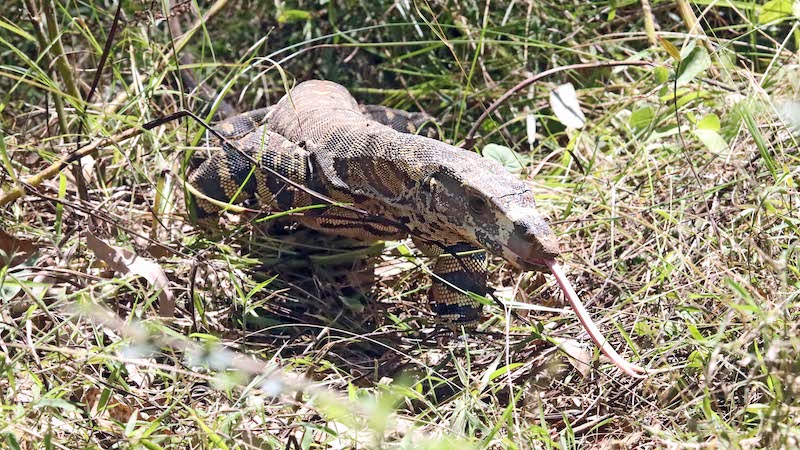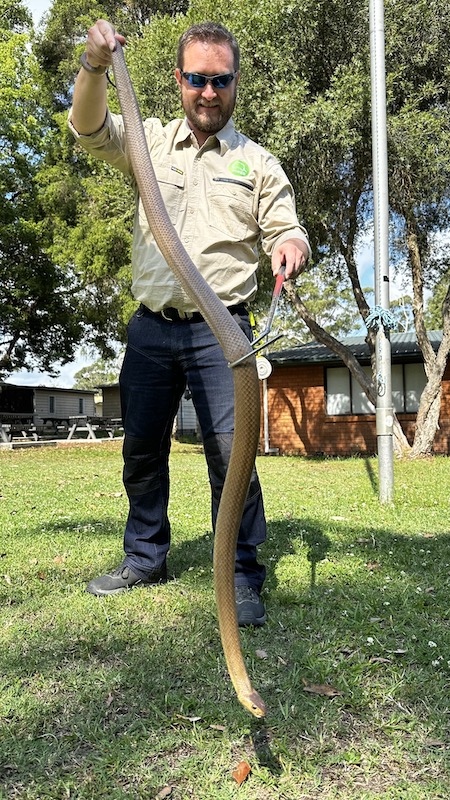
Like most reptiles, lace monitors are susceptible to road accidents. This magnificent monitor was well clear of danger when caught by the camera. Photo: David Flannery.
Goulburn snake catcher Ben Shoard has three basic rules when it comes to catching snakes:
- Never drink alcohol and try catching a snake
- Never touch death adders, they’re the fastest strikers in Australia
- Don’t tail (hold) anything too small, as they are too whippy and will get around and bite you on the hand.
Ben is an apprentice trainer and new chair of the Southern Tablelands branch of the Wildlife Information Rescue and Information Service (WIRES), so catching snakes and helping wildlife comes with the territory.
“The whole point of WIRES is to balance out our interference with wildlife,” Ben says.
“We try to counter the injuries caused by human activity.”
He explains new housing subdivisions on the northern side of the Wollondilly River have displaced numerous native animals. During the construction of homes, small animals such as snakes will find a sheltered area nearby.
“They’re trying to sleep because it’s usually winter,” he says. “Then spring rolls around, they come out from underneath a slab or something like that and, lo and behold, I get a call to a new developed area.”
Learning how to rescue animals can ease the suffering of countless wild creatures and prevent well-intentioned volunteers from being hurt. That’s where the courses offered by WIRES come in.
The Southern Tablelands branch’s next training course for new volunteers will be held on Sunday, 21 January, on rescue and immediate care, which all WIRES volunteers do. More courses will follow on handling venomous snakes and other specialist species, including bats.
“The big thing is getting past people’s high anxiety. They are absolutely terrified,” Ben says.
On the other hand, people who approach snakes full of bravado need to realise they are in danger.
The closest he came to being injured was handling a lace monitor after it had been struck by a car.
“I had someone help put that monitor in the bag and he grabbed it in the wrong spot and ended up getting claws into his arm,” Ben says. “There was quite a bit of damage from that.”
Demand for this type of work is constant in and around Goulburn.
“I remember when Bunnings first opened. There were quite a few snakes, to a point where a snake catcher from Sydney came down for an education course.”

Ben Shoard handling a large eastern brown snake from Dubbo during a recent training course. Photo: Casey Townsend.
Warmer months are the peak time for rescuing birds, including owls, hawks and eagles. These birds of prey need large aviaries for flying while recuperating, but willing people with the space required are limited.
“We have people who are willing to take it on, they just have not had the training,” Ben says.
Consequently, the Southern Tablelands branch has put in an urgent request to WIRES’ head office for training on how to care for injured birds.
Roads, fences, pets and people take a toll on native animals, as does bird netting which can entangle snakes, despite some types being illegal.
Female kangaroos and wombats killed in collisions with cars can leave behind a surviving joey in their pouch. Once rescued, these youngsters need intensive care, including two to three-hourly feeds and a specific temperature.
“We have active members with wombats and kangaroo joeys in care, but they are pushed to their limit, I think,” Ben says.
Cats and dogs are another threat.
“Cats seem to be a killer,” he says.
“I have never had a reptile survive a cat bite. I’ve had the odd one survive a dog bite, but I’m not sure entirely why that is, whether the cats are just better at killing things than dogs, or something to do with the shape of their teeth.”
Volunteers also respond to animals injured by people.
Despite the WIRES volunteers’ best efforts, some injured animals have to be euthanased, and while Ben prefers vets to do this, at times, they are unavailable and he has to act quickly to prevent unnecessary suffering. The Southern Tablelands branch has a qualified shooter to put down larger animals such as kangaroos and wombats, but more are needed.
“No one joins an organisation like WIRES because they want to euthanase animals,” Ben says. “It is one of the most emotionally affecting areas of the role.”
To enrol in a course or learn more information, visit the WIRES website.







